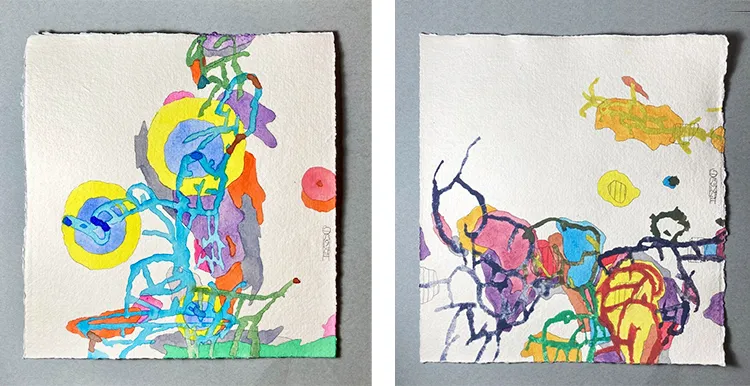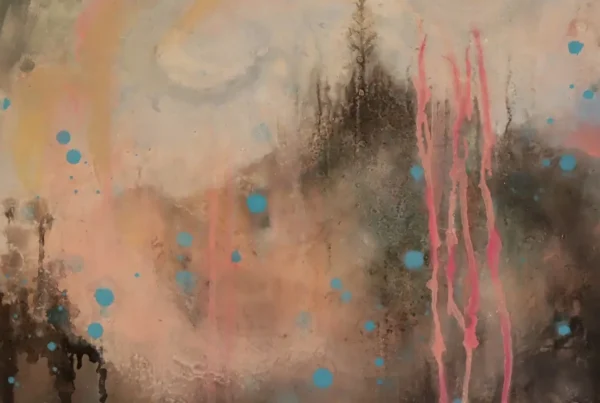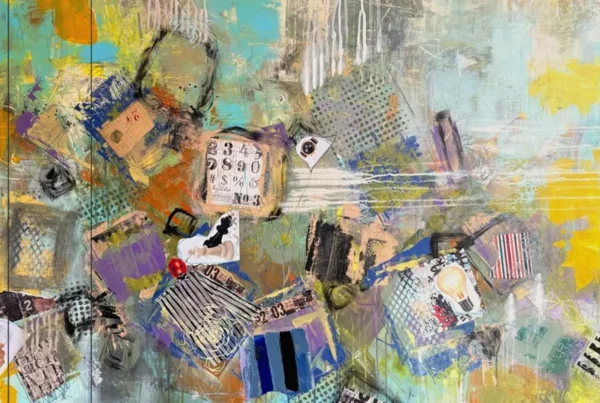“Making art and writing the poems are a meditation practice.”
From War to Art: The Formative Years of Giora Carmi
Born in Israel in 1944, just before it was recognized as a country, Giora Carmi‘s early life was marked by the tumult of national birth and personal tragedy. The Israeli War of Independence in 1948 claimed his father’s life, leaving young Carmi with deep-seated trauma. Despite these early challenges, or perhaps because of them, Carmi turned to art as a means of expression and solace. Art became not just a hobby but a lifelong pursuit, paralleling his careers and evolving with each phase of his life. Initially, his creative output was not the primary source of his income; that would come from his work in graphic design, where he excelled in crafting over 200 book covers, and later, illustration.
Carmi’s move to the United States in 1985 marked a pivotal shift in his career and artistic approach. His work as an illustrator flourished through prestigious collaborations with major newspapers like The New York Times and the Wall Street Journal, and he explored the literary world by illustrating and writing children’s books. Despite these commercial successes, his artistic soul was nurtured through personal exploration and learning, notably his 12-year tutelage under the late Chinese Zen Master Sheng-yen, which profoundly altered his perception of life and art.
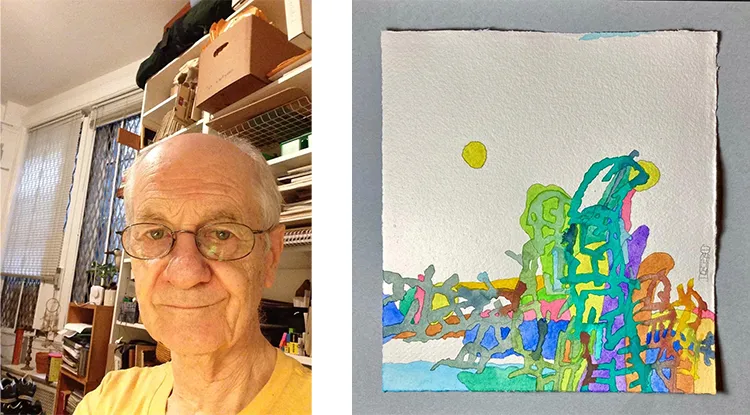
Giora Carmi: Innovating Art Therapy
The influence of Zen on Carmi’s life extended beyond personal transformation; it revolutionized his professional approach to art therapy. Traditionally structured around existing psychological theories, art therapy, as practiced widely, did not venture beyond the cognitive boundaries set by those theories. Carmi, drawing on his deepened understanding of Zen and its principles, developed a novel approach that prioritized intuitive flow over theoretical constraints. This method, which he detailed in his book, Opening Intuitive Flow Through Art Work, now recommended reading at NYU, emphasizes a deeper connection with the subconscious, allowing individuals to explore beyond the surface-level interpretations dictated by conventional psychology.
The evolution of Carmi’s painting style is a direct result of his innovative approach to art therapy. He describes his current methodology as an intuitive process, one that is not pre-planned but rather evolves organically, allowing for a more authentic expression of internal states. This method not only informs his therapeutic practices but also defines his personal artistry. For Carmi, painting and therapy are intertwined, each session an opportunity to delve deeper into the intuitive mind, exploring and interpreting the psychological and spiritual dimensions of his subjects. This approach has led to a unique style of art that serves both as a therapeutic process and a profound medium of personal expression.
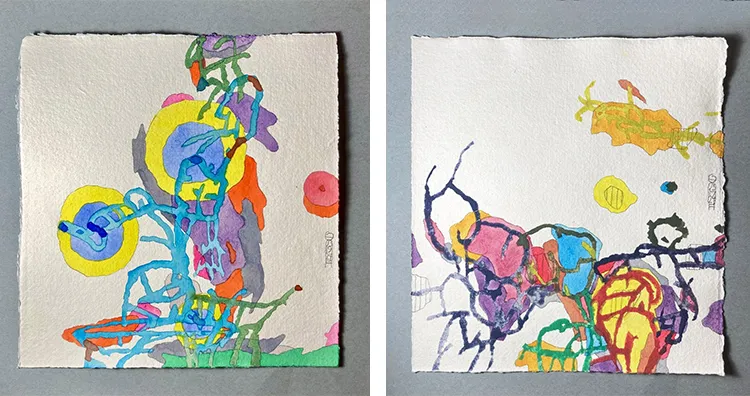
The Art of Intuition: Creative Process
Giora Carmi’s art falls distinctly within the abstract realm, characterized by a lack of representational forms and a focus on the energetic impressions of personal experiences. His paintings are often compared to jazz improvisations, where each stroke and color embodies a spontaneous reaction to internal emotional and spiritual currents. This method of painting, deeply rooted in his Zen practices, transcends traditional art-making by engaging with the subconscious directly. Each session at the easel is a journey into the unknown for Carmi, who begins without preconceptions and often concludes with revelations about his inner state. This intuitive flow is so central to his work that he likens the process to a form of meditation, a practice through which he accesses deeper layers of consciousness.
One particular work, “Everything is Possible Now,” exemplifies Carmi’s reflective practice. Painted without a predefined direction, the artwork revealed itself as a visual metaphor for personal and emotional states. The background features a large, bending flower, heavy and seemingly tired, while blue lines suggest a human figure, the lines like tense muscles. Accompanying this painting, Carmi’s poem reflects the themes of effort, restraint, and potential: “You make an effort to bow / And your muscles ache / You want to shine / But your flower wilts / Where is the whip / That keeps you waiting? / Infinity is all around you / But will not interfere / Everything / Is / Possible / Now.” This piece and its poem poignantly capture the ongoing dialogue between Carmi’s subconscious and his artistic expression, highlighting his journey toward authenticity and the freeing of internal constraints.
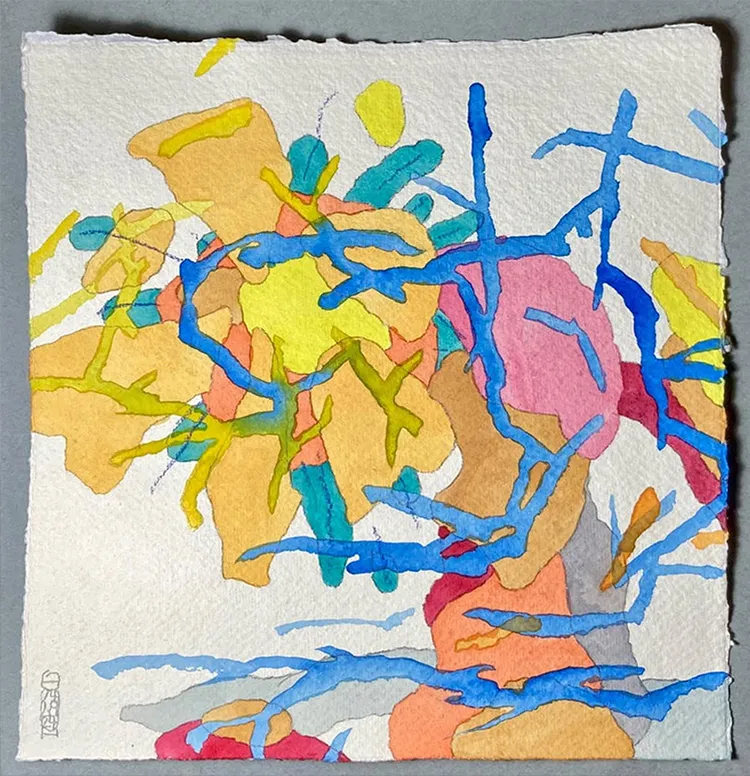
Materials and Inspirations: The Artistic Elements of Giora Carmi
Giora Carmi’s approach to materials is as thoughtful and intentional as his approach to the act of painting itself. Preferring simplicity, he utilizes quality watercolors and gouaches to create his works. The choice between these mediums is strategic; the fluidity of watercolors is perfect for the initial strokes that map out the energy and direction of the artwork, while gouache offers a slight contrast in texture that helps refine and define the evolving composition. Carmi’s method of tearing paper rather than cutting it, and his preference for brushes that have lost their perfect shape, speak to his embrace of the imperfect and the accidental, which he sees as essential to the vitality and authenticity of his art.
Carmi’s influences are as eclectic as his techniques. He draws inspiration from a wide array of artists across different periods and styles, from Paul Klee’s symbolic color palettes to Anselm Kiefer’s textural grandeur. However, the core of Carmi’s artistic philosophy remains steadfastly individualistic—his primary loyalty is to the authenticity of his own creative impulses, which he regards as expressions of a deeper, universal consciousness. This commitment to personal truth over formal stylistic allegiance allows Carmi to remain open to a vast range of influences while maintaining a distinctive voice that is responsive to the nuances of his own experiences and insights. Through this lens, every brushstroke and color choice is a step towards greater self-understanding and artistic expression, making his work profoundly personal yet universally resonant.
